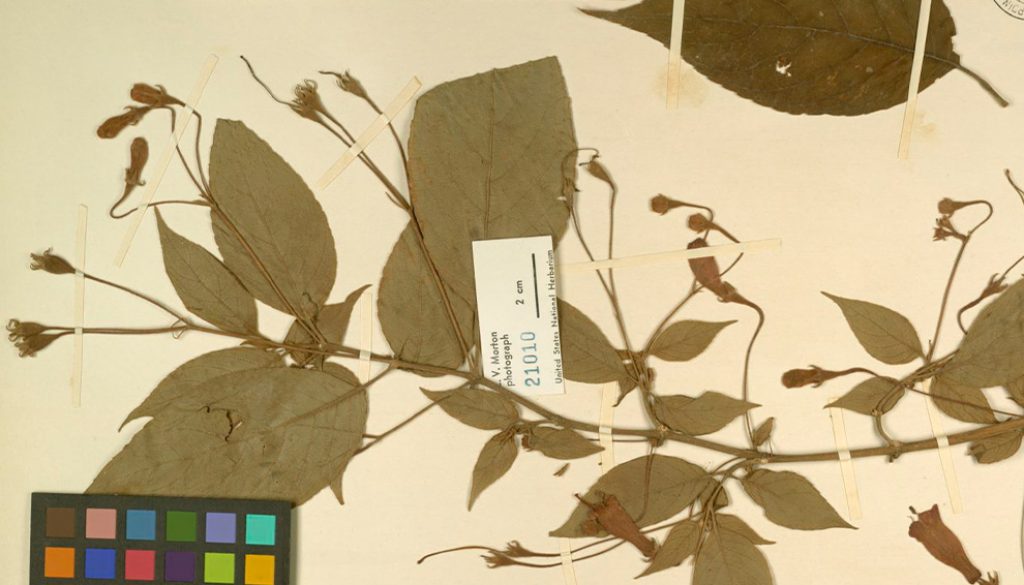Angélica Ramírez-Roa a, *, Laurence E. Skog b
a Universidad Nacional Autónoma de México, Instituto de Biología, Departamento de Botánica, Herbario Nacional MEXU, Tercer Circuito, Ciudad Universitaria, Coyoacán, 04510 Ciudad de México, Mexico
b Smithsonian Institution, National Museum of Natural History, Department of Botany, P.O. Box 37012, Washington D.C. 20013-7012, USA
*Corresponding author: aramroa@ib.unam.mx (A. Ramírez-Roa)
Received: 22 September 2021; accepted: 29 June 2022
Abstract
Moussonia triflora was originally published as Gesneria triflora in 1842 by M. Martens and H. Galeotti without the designation of a nomenclatural type. The analysis of the nomenclatural history includes its being part of 3 genera and as 2 species. The species is one of the 24 taxa included in Moussonia and is known only from the states of Oaxaca and Veracruz in Mexico. The lectotypification of the species is proposed. In addition, an amended description is provided, along with a listing of the examined specimens cited, as well as a key to distinguish similar taxa.
Keywords: H. G. Galeotti; J. J. Linden; Kohleria; Mexico; Oaxaca; Veracruz
© 2022 Universidad Nacional Autónoma de México, Instituto de Biología. This is an open access article under the CC BY-NC-ND license
(http://creativecommons.org/licenses/by-nc-nd/4.0/).
Lectotipificación de Moussonia (Gesneria) triflora (Gesneriaceae)
Resumen
Moussonia triflora fue publicada como Gesneria triflora en 1842 por M. Martens y H. Galeotti sin designarse un tipo nomenclatural. Se analiza la historia nomenclatura del taxón y su pertenencia a 3 géneros y 2 nombres de especies. La especie es una de los 24 taxones incluidos en Moussonia y es conocida solamente de los estados de Oaxaca y Veracruz, México. Se propone la lectotipificación de la especie. Se presenta una descripción corregida junto con una lista de los ejemplares examinados y una clave de determinación de taxones relacionados.
Palabras clave: H. G. Galeotti; J. J. Linden; Kohleria; México; Oaxaca; Veracruz
© 2022 Universidad Nacional Autónoma de México, Instituto de Biología. Este es un artículo Open Access bajo la licencia CC BY-NC-ND
Introduction
In one of their 19 articles entitled “Enumeratio synoptica plantarum phanerogamicarum, ab Henrico Galeotti in regionibus Mexicanis collectarum”, Martin Martens and Henri Guillaume Galeotti in 1842 published an enumeration of 14 species of Gesneriaceae mostly collected by Galeotti during his travels to Mexico from 1835 to 1840 (Crépin, 1883; Martens & Galeotti, 1842; McVaugh, 1978). Nine of those 14 species were new to science, and in the protologues of the new species the authors included: 1) an indication of the “nobis” (or “new”) status; 2) a description in Latin; 3) a discussion of similar species and their differences from the new species; 4) information on the locality, altitude, and phenology; and 5) Galeotti’s collection number of the specimens that would become the types of the new species. The entry for Gesneria triflora M.Martens & Galeotti, now Moussonia triflora (M.Martens & Galeotti) Hanst., includes all this pertinent information except for an explicit citing of a Galeotti specimen that would at present be considered the holotype.
Gesneria triflora was accepted and included in monographs by workers on Gesneriaceae. For example, Hanstein (1865) transferred the species from Gesneria to the genus Moussonia, including as information on its origin “Patria: Mexico: Galeotti”, and citing G. triflora (hence the basionym). Fritsch (1913) later reduced the genus Moussonia to one of the sections of Kohleria. However, as there already existed the combination K. triflora (Hook.) Regel, based on G. triflora Hook. (Hooker, 1847), which currently corresponds to K. hondensis (Kunth) Hanst. (Kvist & Skog, 1992), Fritsch then established K. martensii Fritsch as replacement name for G. triflora M.Martens & Galeotti, even though the latter was the earlier homonym. In the same work, Fritsch stated that he had not seen the type specimen for G. triflora M.Martens & Galeotti and suggested that Galeotti may not have collected the species. Under his proposed replacement name K. martensii indicated a single representative specimen from Veracruz: “Im feuchten Walde, Cerro de Chocaman hinter Cordoba”, C. Seler & E.G. Seler 5182 (B, not located).
Conrad Morton, in 1967, published a synopsis of the genus Kohleria for Mexico, mostly following Fritsch’s (1913) concept of the genus, and in the publication K. martensii was considered to be rare and local species in Veracruz and Oaxaca. Morton included Gesneria triflora M.Martens & Galeotti (which was the replaced name), indicating “Mirador, Veracruz, Mexico” as the type locality, and “Galeotti” as the collector. He included 3 additional representative specimens: Mount Orizaba, Veracruz, E. W. Nelson 294 (US), Comaltepec, above Vista Hermosa, Distr. Ixtlán, Oaxaca, T. MacDougall 506 (US) (fig. 1), as well as C. Seler & E. G. Seler 5182 (B, not located), indicating this last specimen was “cited by Fritsch”.
In 1975 Wiehler re-established Moussonia as a genus distinct from Kohleria, and included M. triflora (M.Martens & Galeotti) Hanst., indicating again Gesneria triflora M.Martens & Galeotti as the basionym and K. martensii as a synonym. No mention of a type or any other specimen was given.
More recently, Moussonia triflora was included in the list of taxa in the reorganization of tribal and generic boundaries of the Gloxinieae tribe by Roalson et al. (2005), as well as in the Index to the Gesneriaceae of the New World (Clark et al., 2020). Also, when one looks for Moussonia triflora (M.Martens & Galeotti) Hanst. in the International Plant Name Index (IPNI, 2021) (https://www.ipni.org/n/77221901-1), its basonym is shown to be Gesneria triflora M.Martens & Galeotti. Likewise, when searching for this latter name (https://www.ipni.org/n/381194-1), it is indicated that it is precisely a synonym of Moussonia triflora (M.Martens & Galeotti) Hanst., without mentioning other associated names. However, if one searches for Kohleria martensii Fritsch (https://www.ipni.org/n/133786-2), then that name is nomenclaturally linked only to G. triflora M.Martens & Galeotti without a mention of M. triflora. In addition, if one attempts to search for Gesneria triflora Hook., no results are found. Nevertheless, searching in the platform of Tropicos.org (2022), for the various species’ names mentioned above one finds a lack of clarity. When one searches for M. triflora (https://www.tropicos.org/name/50081504), one finds that Hanstein is indicated as the author of the species’ name but not noting that M. Martens & Galeotti were the authors of the basionym nor whether Moussonia triflora Hanst. is legitimate or illegitimate. In addition, on the page for M. triflora, 2 names appear, the “Replaced synonym” Gesneria triflora M.Martens & Galeotti, considered there as an illegitimate name and, G. triflora Hook., indicated as a legitimate “blocking name”. When one searches for G. triflora M.Martens & Galeotti (https://www.tropicos.org/name/50081505), 2 “New names” are shown, Kohleria martensii indicated as an illegitimate name and M. triflora with no indication of legitimacy or not. Furthermore, when one searches on the website for Kohleria martensii (https://www.tropicos.org/name/50081503), the name is recognized as nom. illeg. superfl., replacing the “Replaced synonym” G. triflora M.Martens & Galeotti, and the “Blocking name” G. triflora Hook, with no mention of the latter name as being legitimate or illegitimate. In addition, this page includes M. triflora Hanst. as the “Nomenclaturally correct name”. It should be noted that K. martensii was not an illegitimate name when it was published, according to Art. 52.1 of the International Code of Nomenclature (Turland et al., 2018), as it was not a superfluous name, but a replacement name for G. triflora M.Martens and Galeotti, as the blocking name Kohleria triflora (Hook.) Regel (= Kohleria hondensis) had been published earlier based on Gesneria triflora Hook.
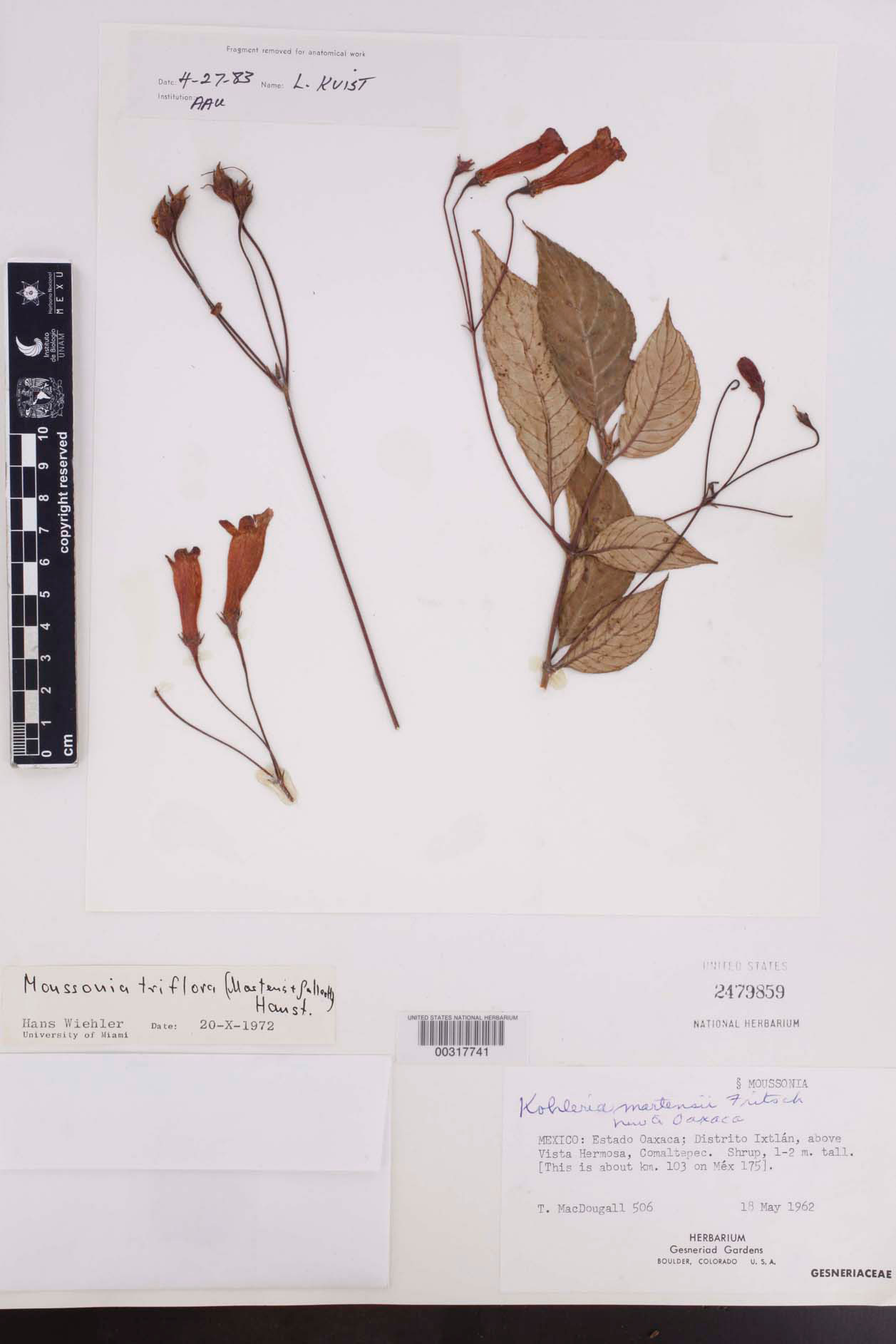
Finally, in the revision of the genus Moussonia, Ramírez-Roa (2017) included M. triflora as 1 of the 23 recognized species, mentioning that the author was unable to locate neither the type specimen supposedly collected by Galeotti nor the specimen Seler & Seler 5182 reported by Fritsch (1913) and Morton (1967) under Kohleria martensii. However, new information about their Galeotti’s and Linden’s travels in México, and their location of their collections now make it possible to propose the lectotypification of M. triflora in this work. An amended description is provided below, as well as additional specimens and images not included in the 2017 work.
Materials and methods
Pertinent specimens were reviewed from the collections at A, BH, BM, C, CAS, CHAPA, ENCB, F, FCMEX, GH, HAL, IEB, INEGI, K, LL, M, MEXU, MICH, MO, NY, OXF, P, SEL, TEX, UAMIZ, UC, US, and XAL (herbarium acronyms according to Thiers, 2020), and Galeotti collections from Veracruz and information were requested from B, BR, GOET, and GZU.
Results
Moussonia triflora (M.Martens & Galeotti) Hanst., Linnaea 34: 286. 1865. Gesneria triflora M.Martens & Galeotii, Bull. Acad. Brussels 9 (2): 33. 1842; Type: Mexico. [Veracruz:] Jalapa, [Jean J.] Linden 442 (lectotype hic designatus: BR! [https://www.botanicalcollections.be/specimen/BR0000013476335] (fig. 2); isolectotypes: BR! [https://www.botanicalcollections.be/specimen/BR00000
13476342] (fig. 3); MICH!) (fig. 4), not Gesneria triflora Hook., Bot. Mag., pl. 4342. 1847 [= K. hondensis (Kunth) Hanst.)].
Kohleria martensii Fritsch, Bot. Jahrb. Engler 50: 428. 1913.
Subshrubs 0.2-2 m in height, with pendulous flexible stems, generally reddish, investiture pubescent to pubescence of lax acroscopic trichomes, but also appearing to be almost glabrous, the few lenticels ellipsoid, flat, almost imperceptibly reddish. Leaves opposite, elliptic-lanceolate to elliptic, sometimes elliptic-obovate, moderately anisophyllous, asymmetric, larger blades in a pair 7.5-15 cm long, 2.7-5.8 cm wide, smaller blades 4.5-5.5 cm long, 2-2.7 cm broad, herbaceous when fresh, apex acuminate, base generally attenuated, oblique, margin shortly serrate towards the apex, ciliate, upper surface dark green to greenish-brown, investiture strigillose, with lax cream-colored trichomes (fig. 5A), underside sparsely to densely strigillose to strigose on veins, greyish-green or yellowish-brown to reddish-brown (fig. 5B), veins cream-colored, secondary veins 7-9; petioles 0.7-3.5 cm long, canaliculate, appressed-pilose. Inflorescences of umbellate cymes of 3 flowers on most of the plant (rarely fewer) (fig. 5C); peduncles (3.5-) 5-11.4 cm long, slender, generally reddish, pubescent-velutinous to shortly velutinous with acroscopic trichomes; pedicels 3.3-6.5 cm, slender, generally reddish, shortly velutinous with acroscopic trichomes, trichomes generally with reddish walls; bracts subulate to ensiform (fig. 5D) 3-10 mm long, 0.5-1 mm wide. Flowers with the floral tube obconic, 2.5-6 mm long, 2.5-3 mm wide, reddish to greenish-brown, hirsute-tomentose to hirsutulous with acroscopic trichomes (fig. 5E-F); calyx lobes deltoid (fig. 5E) to triangular-lanceolate, 2.5-5 mm long, 1.5-3 mm wide, hirsute to hirsutulous with acroscopic trichomes, reddish to greenish-brown; corollas tubular, 2.4-3.5 cm long, almost erect in the calyx, tube 2-2.8 cm long, 4-5 mm wide at the base, ampliate towards the limb, more or less ventricose, throat slightly constricted, 0.8-1.2 cm wide at the throat, red-orange, not translucent, densely hirsute to hirsutulous outside, generally with reddish trichomes, throat yellow, with red elongated maculae; corolla lobes 3-5.5 mm high, obovate, slightly elongate, reddish-orange with reddish lines, margin erose; stamens 2.4-3 cm long, exserted, filaments and anthers yellowish; nectary annular, 5-lobed; ovary sericeous with whitish trichomes, style 2.4-2.7 cm long; stigma stomatomorphic. Fruit an ellipsoid-rostrate capsule (fig. 5G), 1-1.5 cm long, 3-6 mm wide, ribbed, dry, brown, investiture hirsute-tomentose, with acroscopic hyaline to reddish trichomes, or glabrescent; seeds elliptic, 0.4-0.6 mm long, 0.1-0.2 mm wide, striate, reddish-brown.

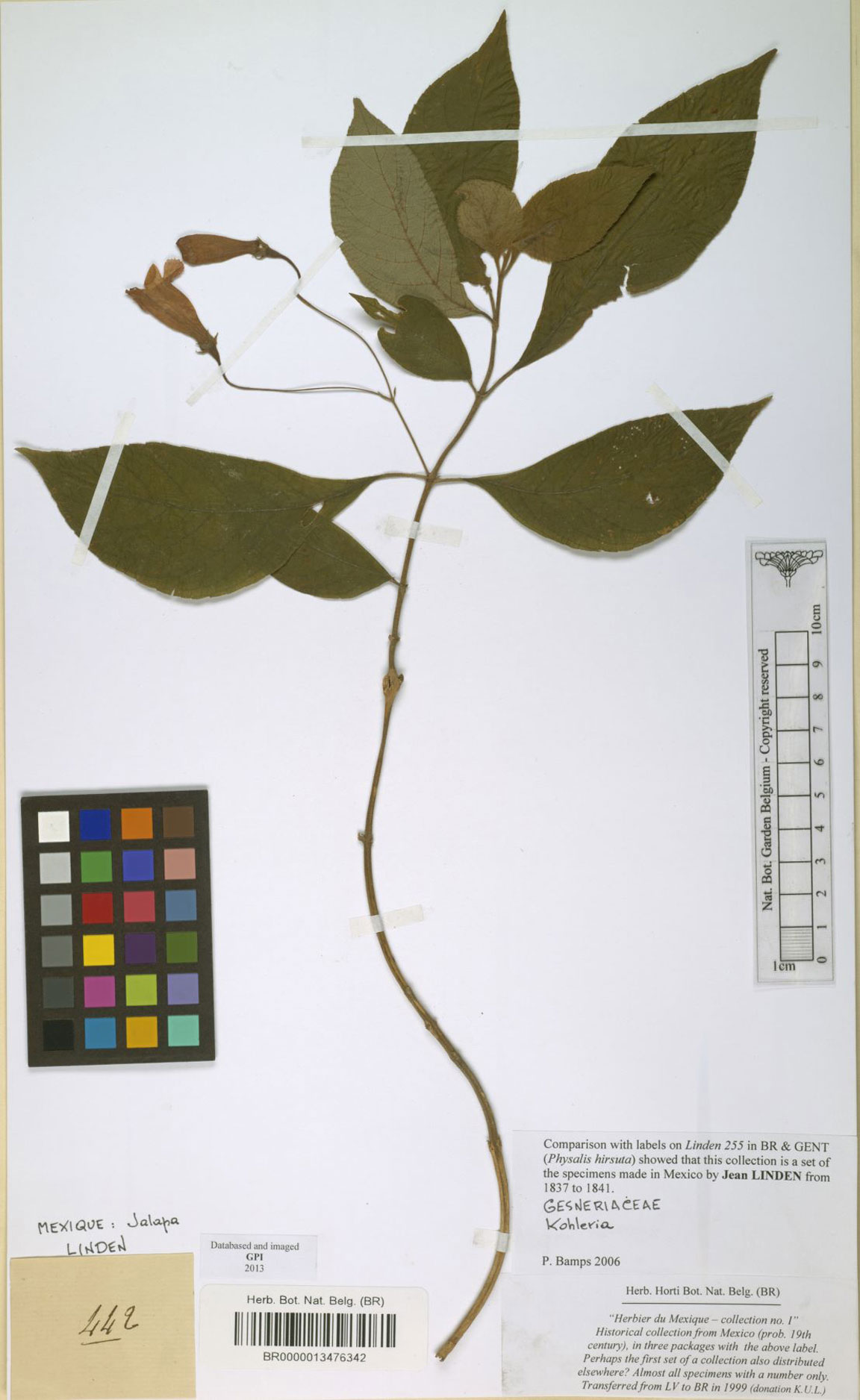
Taxonomic summary
Distribution and ecology. Moussonia triflora has been found in cloud forest, Pinus forests, and Pinus–Quercus forests, in humid and shady places in Oaxaca and Veracruz, Mexico at an elevation of 694 to 2,100 m. The abundance of plants of this species at the collection sites can be scarce to abundant and plants are apparently endemic.
Phenology. Flowering and fruiting specimens have been collected from December to May.
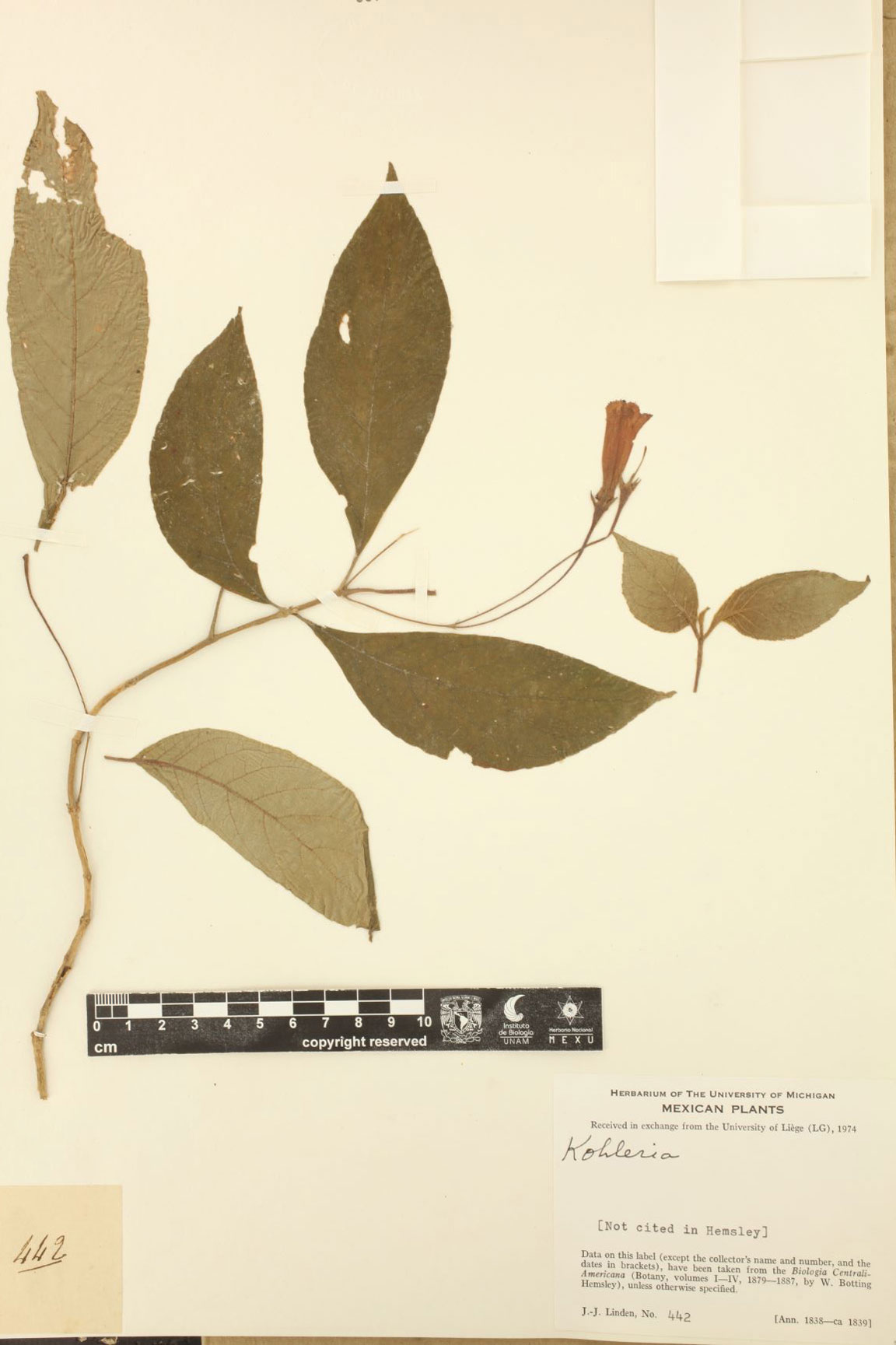
Additional specimens examined: Mexico. Oaxaca, Mun. Santiago Comaltepec, La Esperanza, G. Juárez et al. 3151 (MEXU); distrito Ixtlán, about km 103 on Mex. 175, T. MacDougall 506 (MEXU, US); carr. 175 de Valle Nacional a Esperanza, km 83-84, adelante de Esperanza, junto y antes del mirador, A. Ramírez-Roa et al. 145 (MEXU, MO); 38 km al S de Valle Nacional, sobre la carretera a Oaxaca, J. Rzedowski 34094 (ENCB); 3 km al S de la Esperanza, rumbo a Oaxaca, O. Téllez & J.L. Villaseñor 6745 (MEXU); Dto. Ixtlán, 3.6 km al SO de la Esperanza, carr. Tuxtepec-Oaxaca., R. Torres & L. Cortes 11686 (MO); along half-way between Valle Nacional to Oaxaca, north of Cerro Pelón, H. Wiehler et al. 9120 (MEXU, MO, SEL, US). Veracruz, Mun. Acajete, Rincón de Sedeño, C. Gallardo & P. Rodriguez 3399, 3510 (MEXU); por el camino de Plan de Sedeña hacia Mesa de La Hierba, D.J. Sevilla et al. DJ953 (MEXU); Plan de Sedeño, entrada a Plan de Sedeño, orillas de rio en cañada, P. Zamora & J. López 3864 (MEXU, XAL). Mun. Coatepec, La Crotadura, falda E del Cofre de Perote, G. Castillo 22457 (MEXU, XAL), 21408, 22666, 22742 (XAL); en el punto conocido como Cruz de Duela, C. Gallardo et al. 3048 (MEXU); Loma Alta, V.E. Luna 937 (MEXU, XAL); Loma Alta, 4 km al E de 5 Palos, V.E. Luna 1422 (XAL). Mun. Chimaltengo, road from Jalapa to Misantla, at a small bridge crossing a stream 0.5 mi NE of Chimaltengo, J.V. La Frankie 1064 (GH). Mun. Comapa, road Fortín-Cardel, between Huatusco and Mirador, along roadside, H. Wiehler et al. 9103 (MEXU, US). Mun. Coscomatepec, Cerro La Magdalena, 3 km al S de Tozongo, J.L. Martínez & A. Hernández 1297 (XAL). Mun. Ixhuacán de los Reyes 2 km (by road) W of Ixhuacán de los Reyes and 2.2 km (by road) E of Ayahualulco, M. Nee & C. Taylor 25968 (F, NY, XAL). Mun. Nogales, Nogales, E. Matuda S-110 (MICH). Mun. Orizaba, Orizaba, M. Botteri 282 (GH). Mt. [monte] Orizaba, East slope, E.W. Nelson 294 (GH, US). Mun. San Juan Coscomatepec, El Nacimiento, F. Ventura 3467 (ENCB, F, MICH, NY). Mun. Tlalnehuayocan, 1 km above and NW of San Andrés Tlalnehuayocan, M. Nee et al. 26159 (F, NY, US, XAL). Mun. Xalapa, Paredes al N de Jalapa, carretera a Mizantla, P. Tenorio et al. 3652 (MEXU, MO). Mpio. Xico, gorge at Puente Acabaloya, ca. 1 km SE of Xico Viejo and 5 km NW of Xico, along trail between the 2, remnant of ones on steep slopes of gorge, M. Nee & Taylor 26259 (F, NY).
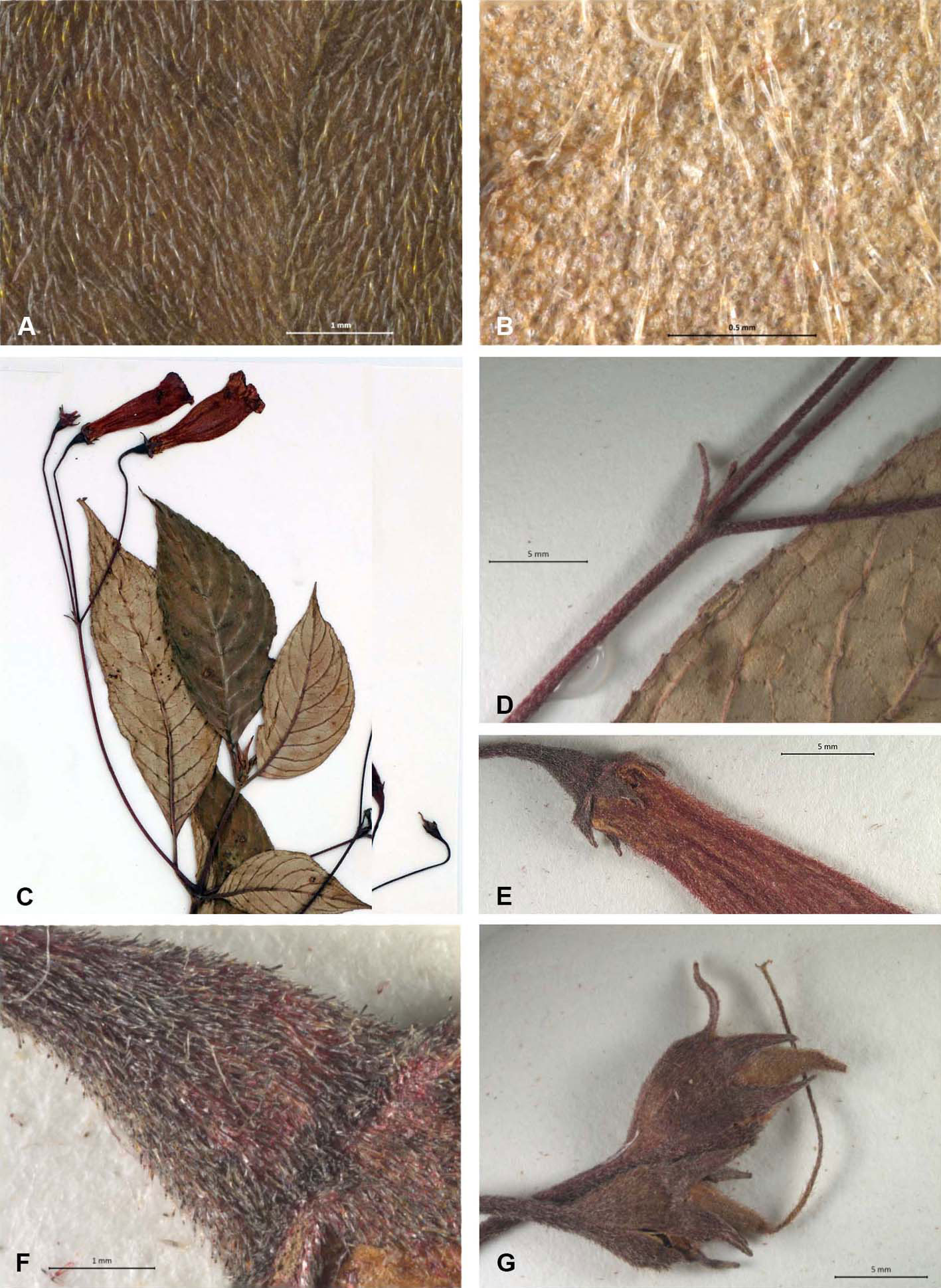
Remarks
Moussonia triflora is distinguished by its flexible and appearing almost glabrous stems, but generally with short pubescence, umbellate cymes of 3 flowers, evidently long and thin peduncles and pedicels, deltoid to triangular-lanceolate calyx lobes, tubular corollas red-orange, yellow inside, ampliate toward the limb, and ellipsoidrostrate fruits.
Although the name of Moussonia triflora indicates the presence of an inflorescence with 3 flowers in each cyme, it is not the only species in Moussonia that might have 3-flowered cymes, for example the recently published, M. pedunculata (Brandegee) Ram.-Roa (Ramirez-Roa & Skog, 2021) has 3 flowers. It is important to note that one may see 3 flowers in any cyme of any branch of species which normally have cymes of 4 flowers, as the fourth flower may not develop (Ramírez-Roa, 2017). The following key may help to distinguish M. triflora from other species with 3 and 4 flowers per cyme.
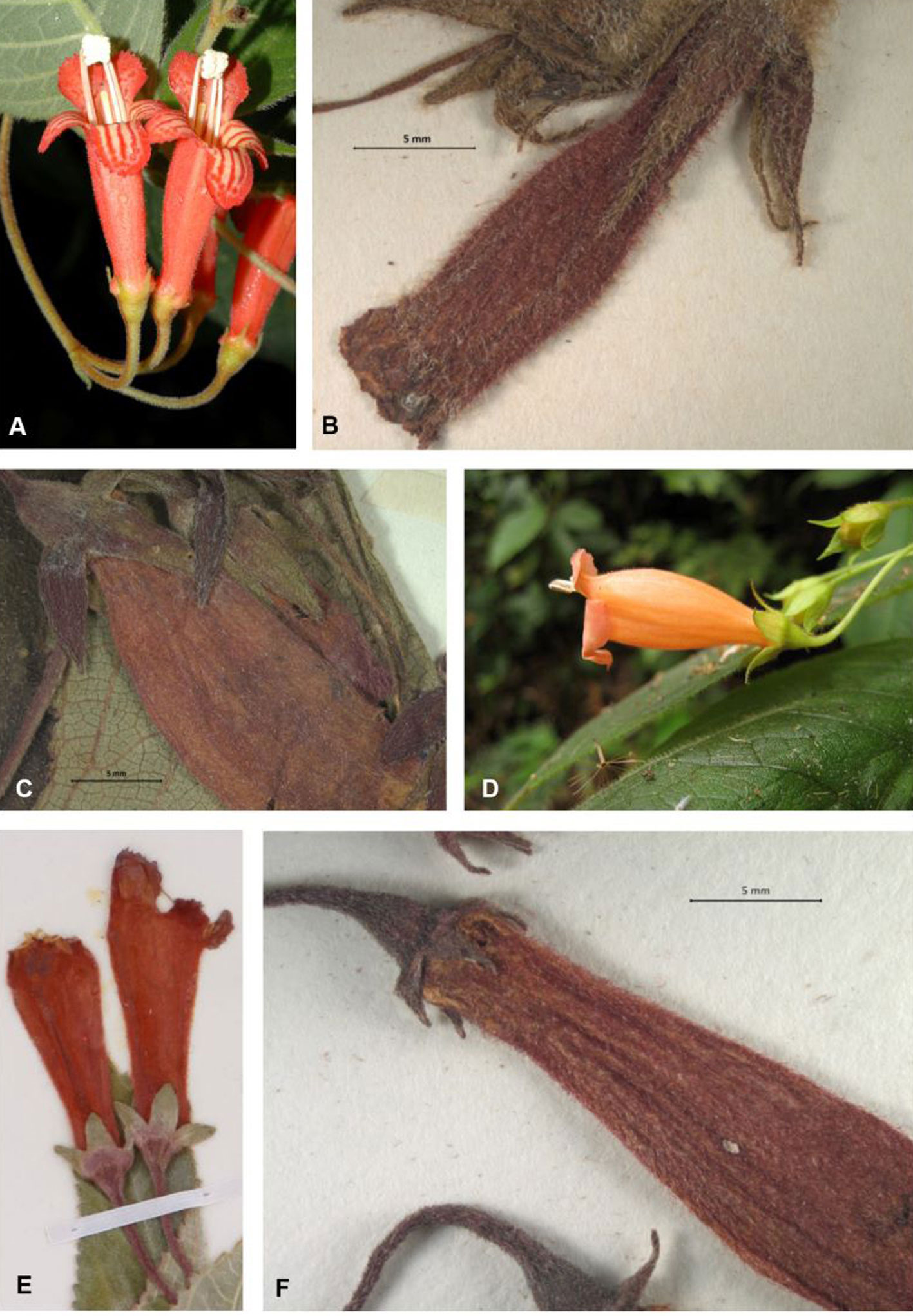
Key to Moussonia species with normally 3 or 4 flowers in the umbellate cymose inflorescences.
1a. Umbellate cymes of 3 flowers.
2a. Pedicels 2.5-3 cm long; bracts elliptic; calyx lobes lanceolate (fig. 6C); Chiapas and Guatemala ……………….. M. pedunculata (Brandegee) Ram.-Roa
2b. Pedicels 3.3-6.5 cm long; bracts subulate to ensiform; calyx lobes deltoid to triangular-lanceolate (fig. 6F); Oaxaca and Veracruz ……………….. M. triflora (M.Martens & Galeotti) Hanst.
1b. Umbellate cymes of 4 flowers.
3a. Leaf upper surface with obvious rugose surface or only towards the margin.
4a. Floral tube densely tomentose with yellowish trichomes; calyx lobes deltoid to triangular (fig. 6A), with acuminate apex; Guerrero, Chiapas, and Guatemala ………………..M. costaricensis Klotzch ex Oerst.
4b. Floral tube villous with whitish trichomes; calyx lobes lanceolate-elliptic (fig. 6B), with acuminate apex; Veracruz and Puebla. ………………..M. papillosa Oerst. ex Hanst.
3b. Leaf upper surface with no obvious rugose surface.
5a. Calyx lobes lanceolate (fig. 6D), red outside; capitate trichomes; Jalisco……………….. M. pendula (C.V.Morton) Ram.-Roa
5b. Calyx lobes shortly ovate (fig. 6E), yellowish; trichomes not capitate; Chiapas and
Guatemala ………………..M. skutchii (C.V.Morton & D.N.Gibson) Wiehler
Discussion
Although M. Martens and H. Galeotti (1842) published Gesneria triflora without designating the holotype, the species is validly published considering the Articles 7.9 and 38.1 in the International Code of Nomenclature (Turland et al., 2018), because it has a protologue which included a Latin description, locality, phenology, as well as comments on its relationship with other taxa of the genus. However, the nomenclatural type designation is pending (Article 7.2), which is presented below.
To justify the selection of the Linden 442 (BR) to be the lectotype for Gesneria triflora M.Martens & Galeotti (Article 9.3), we consider the historical evidence and analyze the protologue. As it was mentioned, the publication by Martens and Galeotti (1842), was about the gesneriads collected by Galeotti in Mexico and it is important to emphasize that each species, whether new or not, has included a Galeotti collection, except for Gesneria triflora. It might be suggested that the lack of indication of the type is due to an omission of the authors. For this reason, collections by Galeotti were sought from the herbarium at the Meise Botanic Garden, Belgium (BR), from which the most complete set of Galeotti is known to exist (McVaugh, 1978). But no specimens of the species have been found there, and according to curators at B, G, NY, OXF, and W a search was also unsuccessful (Ramírez-Roa, 2017), and more recently at E, K, MO, P, and US, where there are some duplicates of Galeotti material (Stafleu & Cowan, 1976). Recently, we asked Dr. Sofie De Smedt, Curator and Project Coordinator from Meise Botanic Garden (BR) to look for any specimen of Galeotti from Veracruz that was among determined or undetermined Gesneriaceae, but again no specimens of the species were found.
Our not finding any Galeotti collections of Gesneria triflora in all the places where his collections are known, it seems appropriate to accept Fritsch’s (1913) suggestion that Galeotti may not have collected any material of the species. However, it difficult to find a reason for his not finding any of this species. It is known that Galeotti explored Mexico from 1835 to 1840, gathering between 7000 and 8000 specimens, many of them new to science (Crépin, 1883; Diagre, 2004), including several from Oaxaca and Veracruz, states from which Gesneria triflora is now known. In addition, about 200 Galeotti numbers are known to be from El Mirador, in Veracruz (McVaugh, 1978), the locality given by Martens and Galeotti for Gesneria triflora: “Cette espèce se trouve avec la précédente dans les environs de la colonie allemande de Mirador, à 3,000 pieds de hauteur. Fl. Rouges. Mai-sept.”
It is also known that Galeotti had been at the Mirador locality from at least September 1838 to March 1839 (McVaugh, 1978). This place was a colony of German immigrants, mainly from 1834 to 1837 (Méndez-Maín, 2011), in which Galeotti and other explorers had their “center of operations” during their explorations in Mexico, thanks to the hospitality of Carl C. Sartorius who hosted all of them in his property “El Mirador” (McVaugh, 1978; Ossenbach, 2009; Schätti et al. 2018; Schuermans-Ceulemans et al., 2006). Interestingly, one of these other explorers was Jean Jules Linden who was traveling and collecting in Mexico in the company of August Ghiesbreght and Nicolas Funck, and had likely crossed paths with Galeotti in at least 2 places, i.e., at Citlaltépetl or Pico de Orizaba in August 1838 (McVaugh, 1978; Diagre, 2004; Schätti et al., 2018) and/or at El Mirador.
Because of Linden’s interests were directed more to plants’ horticultural value and their possible sale, he sought mainly orchids, but also other plants with horticultural potential (Schuermans-Ceulemans et al., 2006; Stafleu & Cowan, 1981a), Linden could have given the plant to Galeotti before the latter returned to Europe in 1840 (Crépin, 1883; McVaugh, 1978, Schuermans-Ceulemans et al., 2006). It is interesting to note that Linden did provide specimens to Galeotti on at least 2 other occasions, namely: 1, Ipomoea lindenii M.Martens & Galeotti [Convolvulaceae] (Bull. Acad. Roy Sci. Bruxelles 12(2): 264. 1845), the type deposited at K, on which both Galeotti and Linden labels can be seen; and 2, the acknowledgements of Linden, Funck, and Ghiesbreght in Richard and Galeotti’s (1845) monograph on orchids of Mexico, in which at the beginning it says: “D’après les échantillons, notes et dessins de MM. Galeotti, Linden, Funck, Ghiesbreght”.
Reviewing material from the Martens’ herbarium deposited at the Meise Botanic Garden in Belgium (BR), the only institution in which an herbarium of Martens is known (Stafleu & Cowan, 1981b), we find the hoped-for specimen, a collection by Linden, J.J. Linden 442 (https://www.botanicalcollections.be/specimen/BR0000013476335), which corresponds to Gesneria triflora M.Martens & Galeotti and is chosen here as a lectotype for the following reasons: 1) the specimen has 2 labels (fig. 2), 1 printed and placed in the specimen’s lower right corner, on which it is indicated that the material is part of the Martens herbarium; and 2) another label, handwritten, placed in the lower left corner, where one can read the name of the species “Gesneria triflora Nobis”, indicating that it is a new species. Also, handwritten are the locality “fl mexic (Jalapa)”, the collector, and collection number “Linden No. 442”.
Regarding the calligraphy of this handwritten label, Dr. Sofie De Smedt (pers. comm.) told us that it could be either Martens or Galeotti, but not Linden who wrote the label. One can see similar handwriting in the work of Dorr (1986) on the collections of Jean-Baptiste Duerinck (1809-1857). His (Dorr’s) figure 3 shows handwritten labels, one of which is from the Martens herbarium, a collection of plants that Duerinck sent Martens as a gift for determination, and is in Martens herbarium in BR. The calligraphy of the label in Dorr’s figure 3 is very similar to the label of Linden 442 (BR 0000013476335), mainly in the letters “l”, “r”, and “s”.
From the information seen on the Linden 442 specimen and its residing in the Martens herbarium at BR, it is likely that Martens and Galeotti used that Linden 442 to describe their Gesneria triflora. It is likely that the authors of the species did not mention the Linden specimen because as can be seen in “Enumeratio synoptica …” of 1842, the authors only designated Galeotti’s material for the family, but Galeotti probably did not want to leave out the one species of Gesneria that he did not collect. But it is likely that the specimens of Linden 442 in BR were the only specimens that Martens and Galeotti had at the time to prepare the description and to name Gesneria triflora.
The specimen selected as the lectotype needs to be compared to the information in the original publication (Martens & Galeotti, 1842). Recommendation 9A.1 and particularly the 9A.2. of the International Code (Turland et al., 2018), indicate that the chosen the lectotype should adhere as closely as possible to the protologue. Some inconsistencies can be seen.
First, the locality on the specimen Linden 442 (BR 0000013476335) is “Jalapa”, while in the protologue the name of the German colony Mirador is given as locality. Reading further, however, it is written that Gesneria triflora M.Martens & Galeotti is found in the same area as “G. elongata H. et B.”, the species on the page before in the same work and in which the locality “la Ville de Xalapa du bourg de Huatusco et de la colonie allemande de Mirador” is indicated. Thus, it is clear that the locality of the lectotype is included in the distribution that the protologue indicates.
Second, the shape of the leaves in the protologue is given as “folia oppositis ovato-lanceolatis acuminatis”, which corresponds to the shape of the largest leaves of the lectotype specimen, but the smaller leaves and in general those observed on the isolectotypes at BR and MICH are elliptic-lanceolate to elliptic, following the concepts of Hickey and King (2000) and Lawrence (1951). Martens and Galeotti (1842) probably took examined the largest leaves or more mature leaves which are ovate-lanceolate, and not the shape of the smaller or younger ones, although it should be mentioned that the great majority of the specimens included in the additional material, also have elliptic or elliptic-lanceolate blades.
Third, the shape of the calyx lobes was described in the protologue as “lobus linearibus acuminatis”, but in the Linden specimens the lobes are deltoid to triangular with acute apices. To this point in which the protologue differs significantly from what we would now describe the shape when examining the lectotype, we must consider that terminology has evolved for describing the shapes of various structures in botany over almost 2 centuries. For example, usages in describing compound leaves, some inflorescences, the peduncle, the pedicel, the pericarp, types of pubescence and, for example, for the term “lanceolate”, Beentje (2016) mentions the change in concept between Linnaeus and Lindley. For the term “linear”, Dr. Beentje (pers. comm.) commented that Lindley (1799-1865) when describing orchids, had in mind structures that we would now define as narrowly elliptic, whereas Linnaeus when using the terms “linearis “ and” linearibus” in Species Plantarum (1753, p. 618), to describe the leaves of Antirrhinum canadense L. [Plantaginaceae], one must think of something a little wider than what is currently considered as “linear”.
What Martens and Galeotti (1842) defined as “lobus linearibus acuminatis”, following Beentje (2016), means a narrow structure much longer than it is wide with parallel margins and a rounded apex. They apparently considered an intermediate form between the concepts of Lindley and Linnaeus, now coinciding with the term “deltoid” (Hickey & King, 2000) or “triangular” (Beentje, pers. comm., Moreno, 1984; Radford et al., 1974) and what we use here.
On the other hand, with respect to the Linden 442 material, 2 very important aspects must be pointed out. One of them is the error that appears in JStor where it is indicated that the herbarium in which the Linden 442 material named Gesneria triflora from Mexico is deposited. GENT is indicated instead of BR (error confirmed by Sofie De Smedt, pers. comm.). The other point of possible confusion is the existence of at least one other set of specimens collected by Linden with number 442. There are 7 specimens that correspond to the type material of the species Alchemilla verticillata Field & Gard. [Rosaceae] collected in April 1842. in Caracas, Venezuela (holotype: K, isotypes: P, BM, U, GH, G, JE). Sofie De Smedt (BR) informed us “it is very common to find duplicate numbers for the Linden specimens. He made 3 trips to Central and South America and every time he started from collection number 1. The first, December 1835 to March 1837, a trip to Brazil (from Rio de Janeiro to the forest of the Mato Grosso and Minas Gerais) with Nicolas Funck (1816-1896) and Auguste Ghiesbreght (1810-1893). The second September 1837 to December 1840, a trip to Cuba and Mexico (from Veracruz to the tip of Yucatan) also with Nicolas Funck and Auguste Ghiesbreght, and along with Henri Galeotti (1814-1858), where they were the first to climb Mt. Orizaba. The third trip was October 1841 to December 1844 a trip to Venezuela and Colombia with his step-brother Louis-Joseph Schlim (1819-1863). After a brief passage in Jamaica in March 1844, they returned to Brussels in December’’. Hence with the knowledge of Linden’s numbering system, and citation of names, collections localities, and the herbarium location of the types, there should be no confusion about the specimens with the same collection numbers.
Finally, regarding the specimen C. Seler & E.G. Seler 5182, cited by Fritsch (1913) and again by Morton (1967) for Kohleria martensii, Ramírez-Roa (2017) indicated that the specimen was not located in the follow herbaria (BM, CAS, F, G, GH, JE, K, MEXU, MO, NY, P, U, or US), and a recent search for the specimen in the Berlin herbarium, B (E. Lücking, pers. comm.), GOET (Marc Appelhans, pers. comm.), and in GZU (A. Scharfetter, pers. comm.) failed. Had a specimen actually been at B, it was probably destroyed during World War II Allied bombing raids (Hiepko, 1978, 1987), as all of the Gesneriaceae specimens were presumed lost. Among the many specimens examined during the research on Moussonia, no specimens have been found of the Selers’ collection or from municipality of Chocamán. However, material has been seen from the municipality of San Juan Coscomatepec, region of Veracruz contiguous to the municipality of Chocamán, F. Ventura A. 3467 (ENCB, F, MICH, NY), which is included in the list of additional specimens examined.
Acknowledgements
We want to express our appreciation to several curators who searched their collections or helped to locate the type material for Gesneria triflora; Kanchi. N. Gandhi (Harvard University) for his illuminating nomenclatural observations that guided the decision in making the typification; Sofie De Smedt (BR) for her valuable information provided about H. Galeotti and J. Linden, as well as for the comments about the label on the Linden specimens and the material in JStor. De Smedt also put us in contact with Denis Diagre-Vanderpelen (Meise Botanical Garden, Belgium), who is thanked for information about the lives of Galeotti and Linden; Henk Beentje (K) for his insightful comments about the shape of the calyx lobes on the type material; Robert. Lücking (B), Marc Appelhans (GOET), and Astrid Scharfetter (GZU) for searching for specimens collected by Seler & Seler; María del Rosario García Peña (MEXU) for facilitating the loans; Gerardo Arévalo Guzmán (IB Library) for his advice and assistance with bibliography and citations; Mauricio Mora and Maribel Paniagua (IB) for the management and maintenance of the Gesneriaceae database; Gerardo and Elsa Varela for their technical support during visits to foreign herbaria; to Julio César Montero (IB) for the graphic material; to the staff of national and foreign herbaria for their support in consulting and loaning specimens; and to the anonymous reviewers for their valuable comments that greatly enriched this work.
References
Beentje, H. (2016). The Kew plant glossary. Kew, UK: Royal Botanic Gardens.
Clark J. L., Skog, L. E., Boggan, J. K., & Ginzbarg, S. (2020). Index to names of New World members of the Gesneriaceae (subfamilies Sanangoideae and Gesnerioideae). Rheedea, 30, 190–256. https://dx.doi.org/10.22244/rheedea.2020.30.01.14
Crépin, F. (1883). “Galeotti (Henri-Guillaume)”. In Biographie Nationale (vol. 7, col. 433–436). Brussels, Belgium: Bruylant-Christophe & Cie.
Diagre, D. (2004). Michel Scheidweiler y Henri Galeotti, los padres del género Ariocarpus (Cactaceae). Elementos, 54, 53–60.
Dorr, L. T. (1986). Jean-Baptiste Duerinck (1809-1857) and his collections from the Middle Western United States. Bulletin du Jardin botanique National de Belgique, 56, 397–416. https://doi.org/10.2307/3668201
Fritsch, K. (1913). Beitrag zur Kenntnis der Gesnerioideae. Botanische Jahrbücher für Systematik, 50, 392–439.
Hanstein, J. (1865). Die Gesneriaceen des königlichen Herbariums und der Gärten zu Berlin, nebst Beobachtungen über die Familie im Ganzen. Linnaea, 34, 225–462.
Hickey, M., & King, C. (2000). The Cambridge illustrated glossary of botanical terms. Cambridge, UK: Cambridge University Press.
Hiepko, P. (1978). Collections at the Botanical Museum Berlin-Dahlem, West Germany saved from destruction in 1943. Willdenowia, 8, 389–400.
Hiepko, P. (1987). The collections of the Botanical Museum Berlin-Dahlem (B) and their history. Englera, 7, 219–252.
Hooker, W. J. (1847). Gesneria triflora: three-flowered Gesneria. Botanical Magazine, 73, plate 4342.
IPNI (International Plant Names Index). (2021). Royal Botanic Gardens, Kew, UK, Harvard University Herbarium & Libraries, Cambridge, Massachusetts, USA, and Australian National Botanic Gardens, Acton, Australia. Retrieval February 19th, 2022 from: http://www.ipni.org.
Kvist, L. P., & Skog, L. E. (1992). Revision of Kohleria (Gesneriaceae). Smithsonian Contributions to Botany, 79, 1–83. https://doi.org/10.5479/si.0081024X.79
Lawrence, G. G. M. (1951). Taxonomy of vascular plants. New York: MacMillan Publishing Co.
Linnaeus, C. (1753). Species plantarum: Exhibentes plantas rite cognitas, ad genera relatas cum defferentiis specificis, nominibus trivialibus, synonymis selectis, locis natalibus, secundum systema sexuale digestas, Vol. 2. Holmiae [Stockholm]: Impensis Laurentii Salvii. http://doi.org/10.5962/bhl.title.669
Martens, M., & Galeotii, H. (1842). Gesneria triflora. Enumeratio synoptica plantarum phanerogamicarum ab Henrico Galeotti in regionibus Mexicanis collectarum. Bulletins de l’Académie Royale des Sciences, des Lettres et des Beaux-arts de Belgique. Bruxelles, 9, 33.
Martens, M., & Galeotii, H. (1845). Gesneria triflora. Enumeratio synoptica plantarum phanerogamicarum ab Henrico Galeotti in regionibus Mexicanis collectarum. Bulletins de l’Académie Royale des Sciences, des Lettres et des Beaux-arts de Belgique. Bruxelles, 12, 264.
McVaugh, R. (1978). Galeotti’s botanical work in Mexico: the numbering of his collections and a brief itinerary. Contribution from the University of Michigan Herbarium, 11, 291–297.
Méndez-Maín, S. (2011). “IV: Veracruz en el siglo XIX. La población en el siglo XIX”. In M. Aguilar-Sánchez, & J. Ortiz-Escamilla (Coords.), Historia general de Veracruz (pp. 1–306). Veracruz, México: Gobierno del Estado de Veracruz, Secretaría de Educación del Estado de Veracruz/ Universidad Veracruzana.
Moreno, N. P. (1984). Glosario botánico ilustrado. Instituto Nacional de Investigaciones sobre Recursos Bióticos. Ciudad de México, Mexico: Compañía Editorial Continental, S.A. de C.V.
Morton, C. V. (1967). The genus Kohleria in Mexico (Gesneriaceae). Baileya, 15, 61–78.
Ossenbach, C. (2009). Orchids and orchidology in Central America. 500 years of history. Lankesteriana, 9, 1–168. https://doi.org/10.15517/lank.v0i0.12019
Radford, A. E., Dickison, W. C., Massey, J. R., & Bell, C. R. (1974). Vascular plant systematics. New York: Harper & Row.
Ramírez-Roa, A. (2017). Revisión del género Moussonia (Gesneriaceae). Ciencia Nueva: Doctorados UNAM. Ciudad de México, México: Dirección General de Publicaciones y Fomento Editorial. Universidad Nacional Autónoma de México https://doi.org/10.22201/dgpyfe.9786070283475e.2017
Ramírez-Roa, A., & Skog, L. E. (2021). Validation of two species’ names in the genus Moussonia (Gesneriaceae: Gesnerioideae). Revista Mexicana de Biodiversidad, 92, e923717. https://doi.org/10.22201/ib.20078706e.2021.92.3717
Richard, A., & Galeotti, H. (1845). Orchidiographie mexicane. Annales des Sciences Naturelles. Botanique / Rédigées Sér., 3, 15.
Roalson, E. H., Boggan, J. K., & Skog, L. E. (2005). Reorganization of tribal and generic boundaries in the Gloxinieae (Gesneriaceae: Gesnerioideae) and the description of a new tribe in the Gesnerioideae, Sphaerorrhizeae. Selbyana, 25, 225–238.
Schätti, B., Ineich, I., & Kucharzewski, C. (2018). Auguste Ghiesbreght’s natural history explorations in Oaxaca and other parts of Mexico until 1854. Acta Zoológica Mexicana (Nueva Serie), 34, 1–22. https://doi.org/10.21829/azm.2018.3411184
Schuermans-Ceulemans, N., Braem, G. J., & Viane, R. (2006). Jean Linden: Explorateur, père des orchidées. Brussels, Belgium: Fonds Mercator.
Stafleu, F. A., & Cowan, R. S. (1976). “Henri Guillaume Galeotti”. In Taxonomic literature: A selective guide to botanical publications and collections with dates, commentaries, and types, 2nd Ed., Vol. 1. A-G. Utrecht, Netherlands: Bohn, Schltema & Holkema.
Stafleu, F. A., & Cowan, R. S. (1981a). “Jean Jules Linden”. In Taxonomic literature: A selective guide to botanical publications and collections with dates, commentaries, and types, 2nd Ed., Vol. 3. Lh-O. Utrecht, Netherlands: Bohn, Schltema & Holkema.
Stafleu, F. A., & Cowan, R. S. (1981b). “Martin Martens”. In Taxonomic literature: A selective guide to botanical publications and collections with dates, commentaries, and types, 2nd Ed., Vol. 3. Lh-O (317–318). Utrecht, Netherlands: Bohn, Schltema & Holkema.
Tropicos.org. (2022). Tropicos.org. St. Louis Missouri Botanical Garden. Retrieved on May 14th, 2022, from https://tropicos.org
Thiers, B. (2020 ongoing). [continuously updated]. Index Herbariorum: A global directory of public herbaria and associated staff. New York Botanical Garden ́s Virtual Herbarium. Retrieved August 2020 from: http://sweetgum.nybg.org/science/ih
Turland, N. J., Wiersema, J. H., Barrie, F. R., Greuter, W., Hawksworth, D. L., Herendeen, P. S. et al. (Eds.). (2018). International Code of Nomenclature for algae, fungi, and plants (Botanical Congress) Shenzhen Code adopted by the Nineteenth International Botanical Congress Shenzhen, China, July 2017. Regnum Vegetabile, vol. 159. Glashütten, Germany: Koeltz Botanical Books. https://doi.org/10.12705/Code.2018
Wiehler, H. (1975). The Re-establishment of Moussonia Regel (Gesneriaceae). Selbyana, 1, 22–31.

